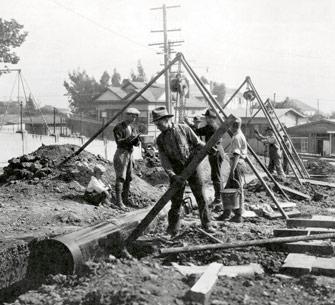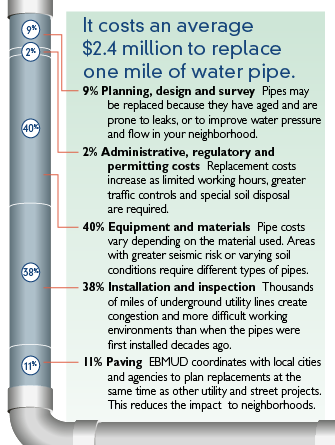Major expansions of the East Bay's distribution system occurred between 1930 through 1960.
Beneath local streets lies a complex network of water pipes. Cast iron, steel and cement—although the materials vary and the dates the pipes were installed span decades, the story below ground is the same. Our local communities could not have grown and flourished without the major infrastructure investments made by past generations of East Bay residents.
Water travels more than 90 miles from the Sierra to your faucet through aqueducts, tunnels and an underground distribution system, most of which is decades, and in some neighborhoods, a century old. The water distribution system serves more than 1.3 million people through about 4,200 miles of pipeline and 170 neighborhood reservoirs.
In the coming years, as our infrastructure continues to age, decisions about where and how to increase investments in water and wastewater systems will shape our generation's legacy.
Managing Our Infrastructure
Major expansions of the East Bay's distribution system took place from the 1930s through 1960s, and EBMUD continues to upgrade and reinforce the water system. Pipes, pumps and other infrastructure are built to last. Still, the East Bay's vast water distribution infrastructure is aging, and an older system means more work to make sure dependable water supplies arrive at customer taps every day.
EBMUD values cost-effective plumbing system improvements and sets priorities by evaluating the performance and reliability of existing facilities, the cost of rehabilitation versus replacement, the impacts of downtime, and how facilities will be used in the future. Projects are planned to minimize inconveniences to nearby homes and businesses (and their customers) and to maintain high reliability with the least cost.
Today, 81¢ of every rate dollar EBMUD collects for water service pays to store, treat and deliver water, day-to-day system maintenance, planning and engineering for future improvements, and to repay bonds sold to pay for long-term investments in infrastructure. These costs are rising, with increased costs for materials, higher labor costs for crews working in congested underground environments, and limitations on work hours to accommodate car traffic.
Cost of Replacing One Mile of Pipe
Replacing aging pipes
More than 4,200 miles of pipelines deliver water to East Bay homes, schools, businesses and hydrants. Much of this underground system is decades old.
Across the nation, leaks and breaks in aging water distribution systems are occurring more frequently. As pipes age, they can be more susceptible to cracking, corroding and even bursting.
EBMUD tracks pipe performance to decide when it is more cost-effective to replace a pipe rather than repairing it when it breaks. Over the next five years, EBMUD plans to replace more than 50 miles of water pipes.